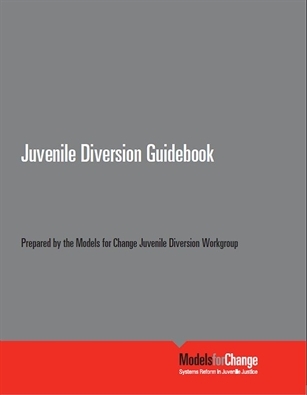Juvenile Diversion Guidebook
Published Mar 1, 2011, Models for Change Juvenile Diversion Workgroup
Download
(813 KB)

Programs that divert youth from involvement in the juvenile justice system have become more frequent in response to the growing recognition that such involvement often is not necessary to achieve society’s goals. The concept of diversion was first adopted by the adult criminal justice system, and in the 1960s, became a topic of discussion in the juvenile justice system. In 1967, the President’s Commission on Law Enforcement and Administration of Justice recommended exploring alternatives for addressing the needs of troubled youth outside of the justice system. In 1976, the Office of Juvenile Justice and Delinquency Prevention’s Special Emphasis Branch provided $10 million in funding for the development of diversion programs. These efforts were driven by the belief that diversion programs might yield many benefits, such as: 1) decreased rates of recidivism; 2) less crowded detention facilities; 3) allowing youth the option to choose an alternative to processing; 4) providing more appropriate treatments at the community level; 5) reducing the stigma associated with formal juvenile justice system involvement; and 6) increasing family participation.
While diversion has been discussed and practiced for nearly four decades, there is little consistency in terms of what actually constitutes a diversion program or process. However, there is a common goal among diversion programs—to minimize a youth’s involvement in the juvenile justice system—but the means and processes to achieve this goal differ in a number of ways, including:
- The segment of the youth population the program targets;
- Who makes the decision as to which youth can or cannot be diverted;
- The processing point in the system at which youth are diverted;
- How charges against the youth are handled;
- Consequences the youth faces for unsuccessful program completion;
- Benefits the youth receives for successful program completion; and
- What community-based services are provided, if any
Likewise, some jurisdictions have diversion programs that are governed by more formal rules and better defined service outcomes than others. Therefore, while diversion continues to emerge as an important practice in the juvenile justice field, these inconsistencies in what constitutes “diversion” call for clarification. This Guidebook was created to offer juvenile justice practitioners a roadmap for addressing these inconsistencies.
It is important for readers to recognize that this Guidebook does not consider all types of diversion programs in juvenile justice. Specifically, it does not consider:
- Diversion efforts after formal adjudication or in juvenile corrections
- Diversion from pre-trial detention
The focus of this document is on diversion programs designed to reduce the likelihood that youth will encounter formal processing prior to formal adjudication. Thus, detention diversion was excluded because it is different from other pretrial diversion situations that prevent youth from formal processing or adjudication. Diversion from detention only diverts youth from being placed in secure custody while still being formally processed. Therefore, diversion programs considered here range from the point of police contact, to pre- and post-petition, and up to the time just prior to formal adjudication.